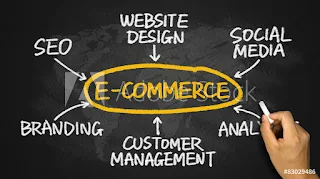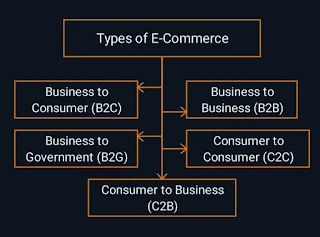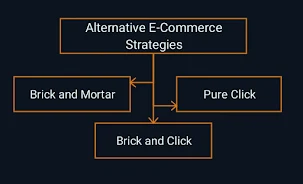Contents :
- Meaning and Definition of E-Commerce.
- Types of E-Commerce.
- Features of E-Commerce.
- Advantages of E-Commerce.
- Disadvantages of E-Commerce.
- Alternative E-Commerce Strategies.
WHAT IS E-COMMERCE ?
Electronic Commerce commonly known as E-commerce or e-Commerce which denotes different types of transactions involved in commercial activities. It contains both organizational as well as individual activities which include the processing and transmission of digitized data such as text, pictures, sound and video, etc.
E-commerce has developed a new environment with the help of Internet in business transactions and processing. Here information is provided direct to the consumers about the products they want to buy and the platform is set for product advertisements. It also permits negotiations, order for raw materials, settlement of financial transactions etc.
Electronic commerce is a combination of communication services, data management and security mechanisms which provides a platform to organizations where they can share information about the selling of goods and services :
1) Communication Services :
Electronic transfer of information from buyer to seller is supported by communication services.
2) Data Management :
It is exchange and storing of data in a constant, format which enable easy exchange of information.
3) Security Mechanisms :
Security mechanisms provides following functions :
- Authenticates the source of information
- Guarantees the integrity and privacy of information.
E-commerce covers many services over the Internet for example, customer service, banking, billing, marketing, retailing, secure distribution of data, corporate sector purchasing and other value-added services.
Meaning and Definition of E-commerce :
The term e-commerce (Electronic Commerce) refers to all types of business operations and transactions that are executed through Internet and other electronic technologies.
"E-commerce is a virtual business environment in which information moves electronically via Internet related to buying, selling, transportation of goods and services".
According to P.T. Joseph :
"E-Commerce comprises core business processes of buying and selling, goods, services and information over the internet".
According to Kalakota and Whinston :
"Electronic Commerce can be defined from following four perspectives :
1) Communications Perspective :
Electronic commerce is the delivery of information, products/services, or payments via telephone lines, computer networks, or any other means.
2) Business Process Perspective :
Electronic commerce is the application of technology toward the automation of business transactions and workflows.
3) Service Perspective :
Electronic commerce is a tool that addresses the desire of firms, consumers, and management to cut service costs while improving the quality of goods and increasing the speed of service delivery.
4) Online Perspective :
Electronic commerce provides the capability of buying and selling products and information on the Internet and other online services."
Types of E-Commerce :
Much of the world's business today is carried out over digital networks that connect people and companies. Several types of e-commerce models are in use today. The major online marketing domains are given below :
1) B2C (Business to Consumer) :
In B2C model of e-commerce, businesses sell products and services to individual consumers directly. All the products and services are offered online through electronic channels in e-commerce which supplements the traditional commerce. Internet acts as an electronic channel.
E-Commerce Examples : www.flipkart.com, www.infibeam.com, www.amazon.in, www.homeshop18.com are websites that comes under this category. Through these websites individual can purchase clothes, mobiles and electronic products etc.
Some of advantages of this model are as follows :
i) Provides better way to deal with suppliersii) Provides customer service centres that are physically locatediii) Provides opportunity to return purchase itemiv) Eliminates middlemen
2) B2B (Business to Business) :
Business-to Business (B2B) e-commerce model describes electronic transactions between businesses such as between manufacturer and wholesaler. The major factors in increasing the acceptance of B2B e-commerce are Internet and dependence of many business operations upon other businesses for supplying raw materials, utilities and services. It is very fast developing segment in e-commerce. Company can check and updates purchase orders, invoices, inventory and shipping status directly through the Internet.
The advantages of B2B e-commerce model are as follows :
i)Reduces cycle tine of inventory and costs.ii) Enables business partners to share relevant information timely with accuracy.iii) Improves supply-chain management among business partners.
iv) Eliminates manual activities and hence reduces errors.
3) C2C (Consumer to Consumer) :
Consumer-to-Consumer (C2C) e-commerce is a business model that facilitates the transactions of product and services between two consumers. In this e-commerce model, consumers sell product and services directly to other consumers using Internet and Web technologies. An individual customer uses classified advertisements to advertise or promote different products and services on web or through online auction sites.
e-Commerce Examples : eBay.com, quicker.com, craigslist.org, gittigidiyor.com. It entails lower cost for both buyer and seller customers. Using this e-commerce model, customers can also advertise and sell their products and services to other employees over organizational Intranet.
4) C2B (Consumer to Business) :
Consumer-to Business (C2B) is an e-commerce model where consumers (individuals) sell products and services which are consumed by businesses and organizations. This model is opposite to B2C model. In this model, price and value for specific products and services are created by individuals.
For example : when a customer writes reviews for new product or gives a useful idea for new product development then he/she is creating value for the company if the company adopts the review or idea. Company can facilitate C2B model by setting discussions forums on their websites.
For example : the websites such as www.mobshop.com, www.pazaryerim.com and www.priceline.com are organizers of C2B transactions.
5) Business-to-Government (B2G) :
In marketing context, B2G marketing is also known as “public sector marketing". It is derived from B2B marketing and is comprised of activities such as marketing of products and services to government agencies. Such marketing is undertaken via various integrated marketing techniques like advertising, branding, managing public relations, online communication strategies, etc.
Features of E-commerce :
Following figure shows the features of electronic commerce :
1) Ubiquity :
E-commerce is widespread, that is, it is available everywhere always. It sets free market from being restricted to a physical space and makes it possible to shop from computer (such as desktop, laptop). The result is called a market space.
For consumers, ubiquity cuts transaction costs for exploring products in a market. Consumers can acquire any information whenever and wherever they want, regardless of their location. It is no longer necessary that buyer spend time and money for traveling to a market. In all, it saves the cognitive energy needed to transect in a market space.
2) Global Reach :
E-commerce technologies enable a business to easily reach across geographic boundaries around the earth far more conveniently and effectively as compared to traditional commerce. Globally, companies are acquiring greater profits and business results by expanding their business with e-commerce solutions. As a result, the potential market size for e-commerce merchants is approximately equal to size of online population.
3) Universal Standards :
Universal Standards are standards shared by all the nations around world. These are technical standards of Internet for conducting e-commerce. It gives all the ability to connect at the same "level" and it provides network externalities that will benefit everyone. Universal technical standards lower entry costs and minimal search costs.
4) Interactivity :
E-commerce technologies permits two-way communication between customer and sellers which makes it interactive. It proves as significant feature of e-commerce technology over the commercial traditional technologies of the 20th century.
5) Information Density :
Information density means total amount and quality of information available over Internet to all market buyers and sellers. Internet vastly increases information density. Information density offers better quality information to consumer and merchants. E-commerce technologies increase accuracy and timeliness of information. For example, flipkart.com store has variety of products with prices.
6) Richness :
Richness refers to the complexity and content of a message. Richness means all commercial activity and experience, conducted through a variety of messages. For example, text, pictures, videos, sound, links, SMS (Short Message Services) etc.
7) Personalization :
E-commerce technology offers personalization. Personalization means designing marketing messages according to particular individuals by customizing it as per customer personal details like name, interests, and past purchases record. Products or services can be modified or altered according to the user's choice or past buying record.
Advantages of E-Commerce :
The advantages/benefits of e-commerce can be divided into two categories :
Advantages of E-Commerce to Customers :
1) Reduced Prices :
The products available on websites have reduced prices because the different stages of value chain are decreased between source and destination. The intermediaries such as retail store are eliminated by the company and they sell their products to consumer directly instead of distributing through intermediaries.
2) Global Marketplace :
E-commerce provides global marketplace from where consumers can purchase products according to their needs situated anywhere in the world.
According to World Trade Organization (WTO), "there are no custom duties put on products bought and traded globally electronically".
Global Marketplace also provides large collection of products and services to consumers With their prices.
3) Anytime Access :
Online businesses are open 24 hours, 7 day a week and 365 days in a year and never sleep. Consumers can do transactions and enquiry about any product/services provided by company at anytime and anywhere from globe. Consumer can purchase any product in day or night using Internet connections and computer at single click of mouse.
4) More Choices :
Online businesses provide their consumers more choices of purchasing. Before purchasing any product, consumer can study products and their features of all major brands.
5) Quicker Delivery :
E-Commerce offers consumer more options and provides quicker delivery of products and services. Some e-commerce company provides free home delivery service to their consumers.
6) Relevant Information :
E-commerce provides relevant and detailed information about products and services within seconds to its consumers. Consumer can compare products and their prices in easy manner.
Advantages of E-Commerce to Businesses :
1) Low Barriers to Entries :
In today's world, small and large firms have opportunities to start up and conduct business on the Internet. Firms entry cost to the Internet is minuscule (Very small) because they do not need the space for rent. All the business over Internet are virtual means that there is no need of large number of employees to conduct business.
2) Increased Potential Market Share :
Businesses are increasing their market share by making their business internet enabled. Online businesses are accessed at any time to international markets.
3) Low-Cost Advertising :
Internet provides low cost advertisement as compared to advertisement on newspapers or television. In today's world, Internet has become inexpensive advertising medium used by firms for commerce. The different methods of advertising are : e-mail, banners, pop-ups, steaming video and audio etc.
4) Strategic Benefit :
E-commerce enabled business have many strategic benefits because they :
a) Reduces cost of mail preparation, document preparation and data entry.b) Finds errors easily.c) Lowers cost of calling over telephone.d) Lowers delivery time and labour costs.e) Lowers data entry and management expenses.
5) Global Reach :
E-commerce enabled business has ability to reach globally at low cost. They are able send messages world-wide at any time. Since online businesses are globally accessed so e-commerce helps to attract new consumers and business clients from anywhere in the world.
Disadvantages of E-Commerce :
The disadvantages/limitations of e-commerce can be divided into two categories :
Technical Disadvantages of E-Commerce :
1) Lack of Security :
Consumer needs to be confident and trust over e-commerce payment providers. Any fraud, hacking or forgery can break the trust of consumer.
2) Low Bandwidth :
In many countries, network might cause an issue because of low bandwidth.
3) Difficulty in Integrating E-Commerce :
It is difficult to integrate e-commerce software or website with the some existing applications and databases. Vendors need special web servers to, deal with integration problem in addition to network servers.
4) Not All Customers have Access to Internet :
Internet access is not universally available so much of the effort made does not actually reach the consumer. Many potential customers that are living in remote villages have not Internet access facility.
Non-Technical Disadvantages of E-Commerce :
1) Initial Cost :
The initial cost to develop e-commerce web site in-house is very high. This may need high cost of hiring qualified staff to maintain and updating e-commerce web site. There are also companies have opportunities for outsourcing e-commerce to other e-commerce companies. But where and how to do outsourcing is a difficult task.
2) Security and Privacy :
The major issues in online businesses are security and privacy. Customers feel hesitant to disclose credit card numbers over Internet because of security problems such as theft of credit card number. If consumers do not have any confidence on the online business, they will refuse to purchase anything over the Internet.
3) Lack of Trust and User Resistance :
Face-to-face contact and paper transactions are important in business deals and transactions since it is related to trust. So for any consumer switching from physical to online stores is difficult.
4) Lack of Touch and Feel :
Consumers may want to touch and feel a product before purchasing online. Online businesses do, not provide the touch and feel experience to consumer on items such as clothes, shoes etc.
5) Customers Relation Problems :
Organization needs loyal customers to run their online business for long time. Online businesses cannot continue without loyal customers in today's competition.
6) Corporate Vulnerability :
Online businesses have high availability of information related to product, price, catalogs, and others. This information makes web sites vulnerable to access by competition. This process of extracting business intelligence from competitor's web pages is called Web farming.
7) Legal Issues :
When buyers and sellers do not know each other, there is, chance of fraud over the Internet. Hence there are many legal problems related to e-commerce. Some common legal issues encountered in e commerce are :
a) Software and Copyright Violationsb) Credit Card-Fraud and Stolen Identitiesc) Illegal Bargains and Criminal Law
Alternative E-Commerce Strategies :
Alternative e-commerce strategies reveal different commerce strategies developed with the help of integration of business processes with new internet technologies. Some of these alternatives are as follows :
1) Brick and Mortar :
The phrase "brick and mortar' means a physical or tangible asset.
For example, a building, plant, storage facility, production unit, etc. Brick and mortar is one of the traditional business models which involve the use of websites just for the purpose of using it as company's brochure. Websites here serve as a means for providing information about the company. Such companies use the traditional sales methods for generating profits. However, if the company gets a favorable market feedback, then these companies can expand further into 'brick and click' companies adding to their online presence.
2) Pure Click :
Unlike brick and mortar companies, pure click companies have pure online presence. Their entire marketing transaction is undertaken online. These companies are popularly known as 'pure-plays' or 'dotcoms'. The various elements associated with the 'pure click' companies are Internet Service Providers (ISPs), commercial sites, content sites, transaction sites, enabler sites, search engines, etc. Some of the popular search engines used by pure click companies are Google, yahoo, Sify, Alta Vista, etc. These search engines also offer various services like free mailing, news, weather reports, entertainment, etc., on company's website. Major examples of 'pure click' companies are Flipkart, Amazon, EBay, India times etc.
3) Brick and Click :
Companies that fall under the category of brick and click' model have both online and offline presence. This means that their marketing and transactional activities are carried on both online as well as offline mode. They need to manage their online and offline activities and should ensure that their online sales do not affect their traditional (offline) sales. They also need to manage their channel conflicts which may arise among their intermediaries and conflicts arising in online sales. Some of the companies like Avon and Compaq launched their online sales models in such a way that it actually supported their traditional offline sales instead of disrupting it. Similarly, one of the popular store Wal-Mart introduced its subsidiary firm in January, 2000 namely Walmart.com which helped customer to access its services online offering more than a million products on internet. This retailing firm involves use of web-based technology as well as standardized retailing strategies for attracting customers.
TOP TREADING ARTICLE FOR COMMERCE STUDENTS :




